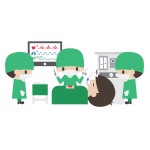The Brachial Plexus is an intricate network of nerves that originate and pass from the spinal cord to the arms, shoulders, and hands. Understanding the complex anatomy and function of the Brachial Plexus is very important for healthcare professionals, medical students, and nurses. However, memorizing the various nerve branches of the brachial plexus and their functions can be a daunting task. That’s where a Brachial Plexus mnemonic comes in handy. Today, in this article very going to share with you a set of medical mnemonics to help you remember the Roots, Trunks, Divisions, Cords, and Branches of the brachial plexus, as well as associated nerve lesions too.
Before we dive into the mnemonics, here’s a quick graphical overview of the brachial plexus: ![]()
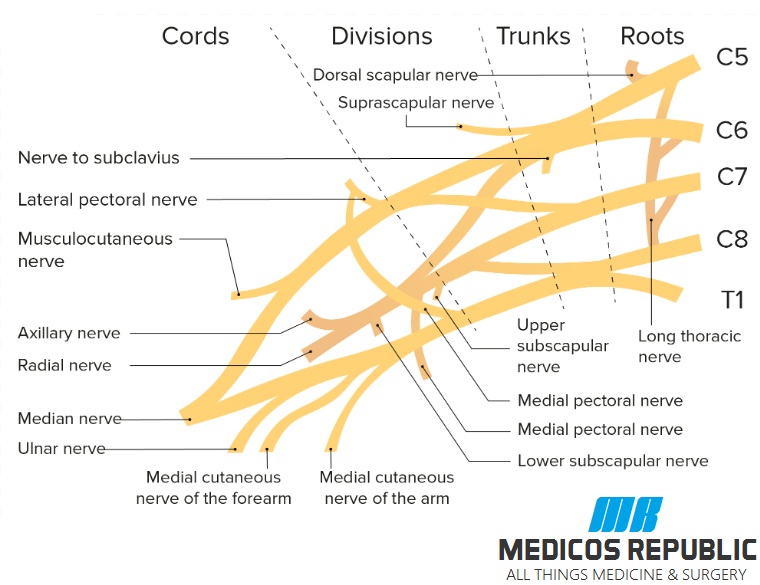
Brachial Plexus High-yield Anatomical Facts
Below are some high-yield anatomical facts on the Brachial Plexus presented in a table format to help you memorize them easily. 🙂
| Fact | Description |
|---|---|
| Location | Located in the neck and axilla regions |
| Nerve Roots | Originates from the C5-T1 spinal nerves |
| Main Trunks | Consist of superior, middle, and inferior trunks |
| Divisions |
Each trunk divides into an anterior and posterior division as shown below: Three anterior divisions of the brachial plexus Three posterior divisions of the brachial plexus |
| Cords | The anterior divisions of the superior and middle trunks form the lateral cord, the anterior division of the inferior trunk forms the medial cord, and the posterior divisions of all three trunks form the posterior cord |
| Branches | The Brachial Plexus gives rise to five main branches:
|
| Functions | The Brachial Plexus provides innervation to the muscles and skin of the upper limbs and is responsible for motor and sensory functions such as arm movement and sensations in the hand |
These are some of the very important anatomical facts that one should be well-acquainted with when studying the Brachial Plexus. Understanding and memorizing the location, nerve roots, main trunks, divisions, cords, branches, and functions of the Brachial Plexus is crucial for medical students and healthcare professionals alike.
Brachial Plexus Nerve Lesions
Below are important nerve lesions of the Brachial Plexus presented in a table format with a photo of each nerve lesion to help you better understand:
Erb-Duchenne Palsy
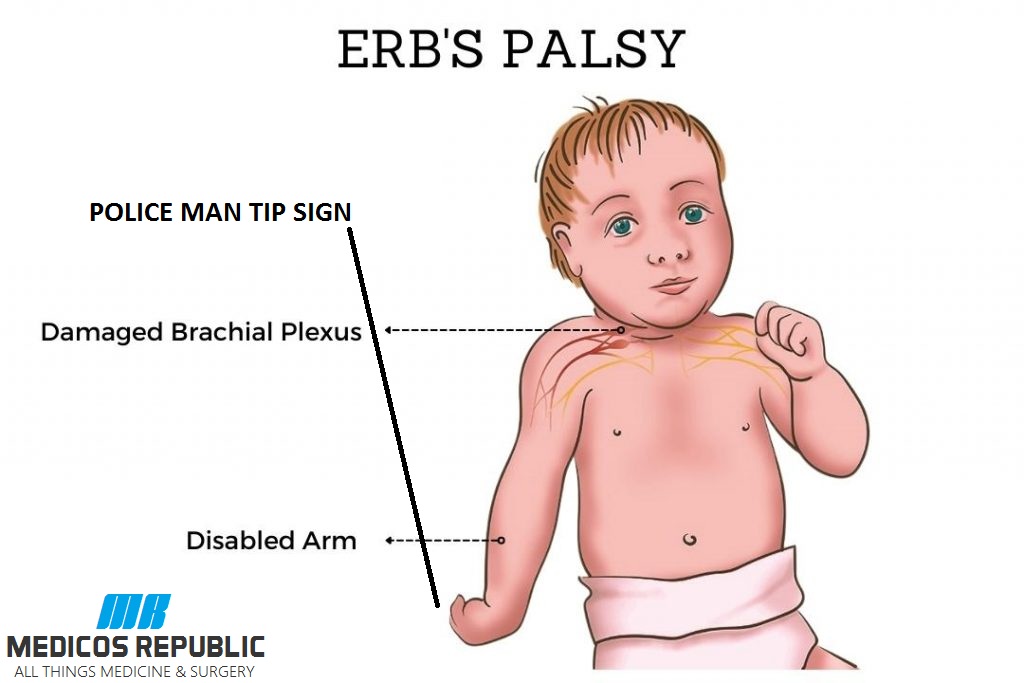
It occurs as a result of a lesion of the upper trunk (C5-C6) causing weakness of the shoulder, upper arm, and forearm muscles. This leads to a characteristic “waiter’s tip” posture (also referred to as policeman tip sign) where the arm is held in extension, adduction, and medial rotation. Occasionally, sensory loss may also occur in the upper limb.
Klumpke’s Palsy
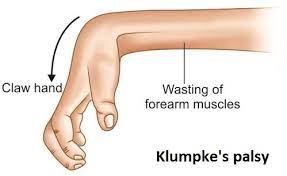
Damage to the lower trunk (C8-T1) causes paralysis of the hand and wrist muscles. This can potentially result in a claw-like deformity of the hand and fingers. In addition, sensory loss may also occur in the forearm and hand.
Thoracic Outlet Syndrome
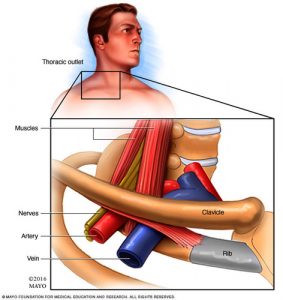
It occurs due to compression of the Brachial Plexus as it passes through the thoracic outlet, resulting in pain, numbness, and weakness in the upper limb. This can be caused by a variety of factors, including mechanical accidents, violent compression, poor posture, repetitive motion, or anatomical abnormalities.
Long Thoracic Nerve Palsy
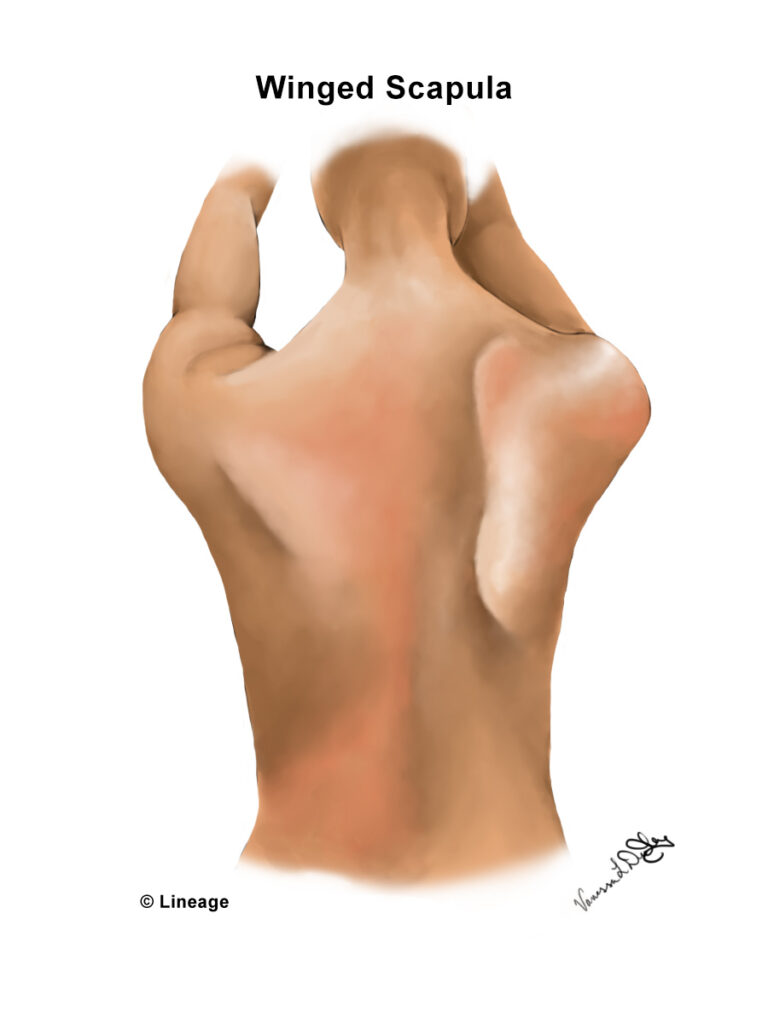
It occurs as a result of a lesion of the long thoracic nerve, which arises from the C5-C7 nerve roots and innervates the serratus anterior muscle. A defect here can potentially result in weakness or paralysis of the serratus anterior muscle, causing scapular winging (a.k.a winged scapula) and difficulty with overhead arm movements.
Radial Nerve Lesion
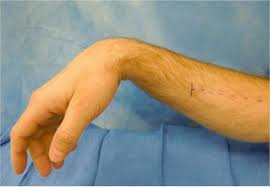
Lesion of the radial nerve, which can occur at different anatomical positions along its course. Depending on the location and severity of the lesion, symptoms can include:
- Weakness or paralysis of the wrist and finger extensors
- Loss of sensation in the dorsal hand and forearm
- Wrist drop.
Ulnar Nerve Lesion
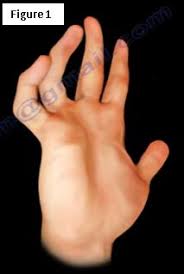
- Weakness or paralysis of the hand muscles responsible for fine motor movements
- Loss of sensation in the ulnar aspect of the hand and forearm
- “Claw hand” deformity
Median Nerve Lesion
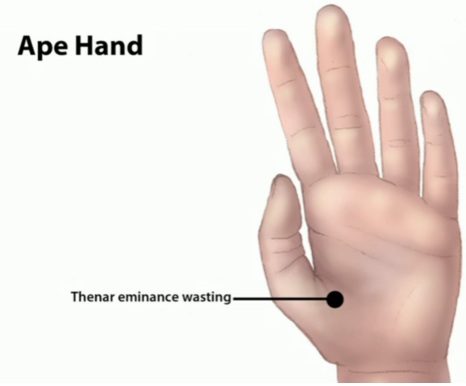
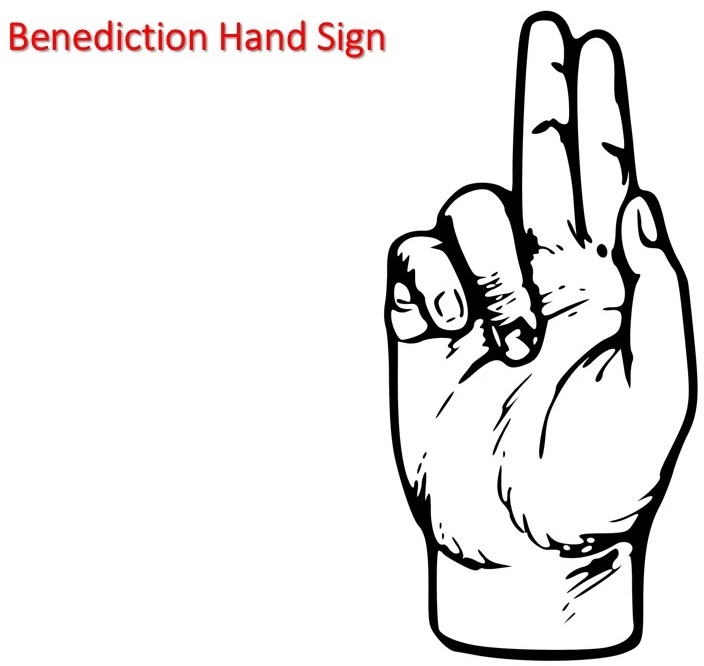
Depending on the anatomical location and severity of the median nerve lesion, symptoms can include:
- Weakness or paralysis of the thumb, index finger, and middle finger muscles
- Loss of sensation in the palmar aspect of the hand
- “Ape hand” deformity.
- “Benediction Hand Sign” deformity
So, these are some important nerve lesions that can occur in the Brachial Plexus. It is important that healthcare professionals and medical students should be familiar with them in order to diagnose and treat patients with Brachial Plexus injuries.
Brachial Plexus Mnemnonic
Memorizing the components and nerve lesions of the Brachial Plexus can be very difficult, but using mnemonics can be a helpful tool to retain important information. The below table provides several useful brachial plexus mnemonics, such as “Rugby Teams Don’t Cover Bruises” and “DR. CUMA,” which can be really helpful in recalling the structure and function of the Brachial Plexus. These mnemonics can be particularly useful for medical students and nurses who need to be able to quickly recall these details during exams or clinical practice. By utilizing these useful Brachial Plexus mnemonics, one can gain an improved understanding of this crucial anatomical structure. 🙂
[adinserter block=”2″]
Here are the high-yield Brachial Plexus mnemonics in a table format:
| Organization | Mnemonic |
|---|---|
| Roots, Trunks, Divisions, Cords, Branches | ‘Rugby Teams Don’t Cover Bruises’ |
| Lateral cord branches | ‘Rugby players are Long Legged Movers’ (Lateral pectoral nerve, Lateral root of median nerve, Musculocutaneous nerve) |
| Medial cord branches | ‘Rugby players Make Many Moves Using Muscles’ (Medial cutaneous brachial nerve, Medial cutaneous antebrachial nerve, Medial pectoral nerve, Ulnar nerve, Median root of median nerve) |
| Posterior cord branches | ‘Rugby players are ULTRA competitive’ (Upper subscapular nerve, Lower subscapular nerve, Thoracodorsal nerve, Radial nerve, Axillary nerve) |
| Nerve lesions | ‘DR. CUMA’ (Dropped wrist = Radial nerve lesion, Claw hand = Ulnar nerve lesion, Ape hand = Median nerve lesion) |
We hope that you find this blog post useful in your studies. Happy learning, folks! 🙂
ALSO CHECK OUT: 🙂
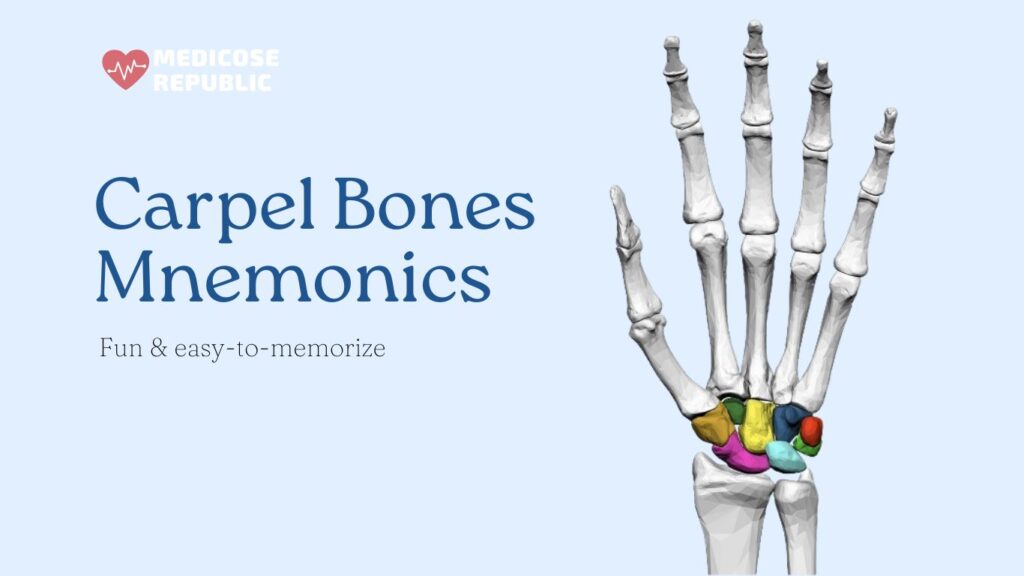

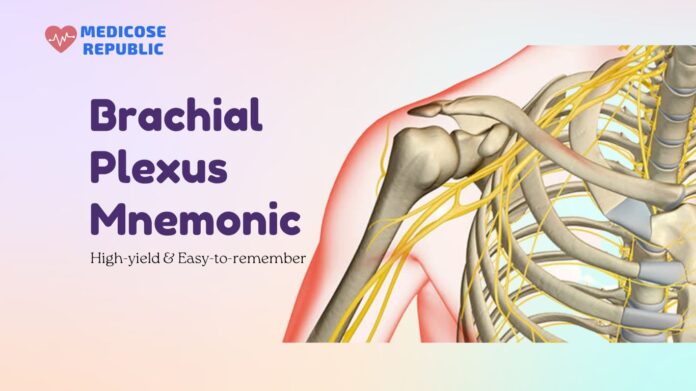



![Carcinoid Syndrome Mnemonic [Easy-to-memorize] Carcinoid Syndrome Mnemonic](https://www.medicosrepublic.com/wp-content/uploads/2024/08/Carcinoid-Syndrome-Mnemonic-Easy-to-memorize-218x150.jpg)

![Stages of Neurocysticercosis Mnemonic [Vegans Can’t Get Neurocysticercosis] Stages of Neurocysticercosis Mnemonic](https://www.medicosrepublic.com/wp-content/uploads/2023/08/Stages-of-Neurocysticercosis-Mnemonic-Vegans-Cant-Get-Neurocysticercosis-1-218x150.jpg)

![SOAP for Family Medicine 2nd Edition PDF Free Download [Original Quality] SOAP for Family Medicine 2nd Edition PDF](https://www.medicosrepublic.com/wp-content/uploads/2023/02/SOAP-for-Family-Medicine-2nd-Edition-PDF-150x150.jpg)
![Encyclopedia of Counseling 4th Edition PDF Free Download [Direct Link] Encyclopedia of Counseling 4th Edition PDF](https://www.medicosrepublic.com/wp-content/uploads/2023/02/Encyclopedia-of-Counseling-4th-Edition-PDF-Free-1-150x150.jpg)
![Prioritization, Delegation and Assignment: Practice Exercises for the NCLEX-RN® Examination 5th Edition PDF Free Download [Direct Link] Prioritization, Delegation and Assignment Practice Exercises for the NCLEX-RN® Examination 5th Edition PDF](https://www.medicosrepublic.com/wp-content/uploads/2023/01/Prioritization-Delegation-and-Assignment-Practice-Exercises-for-the-NCLEX-RN®-Examination-5th-Edition-PDF-Free-Download-150x150.png)
![ICD-10-CM 2019: The Complete Official Codebook 1st Edition PDF Free Download [Direct Link] ICD-10-CM 2019: The Complete Official Codebook PDF](https://www.medicosrepublic.com/wp-content/uploads/2019/05/ICD-10-CM-2019-The-Complete-Official-Codebook-PDF-150x150.jpg)

![Pre-Clinical Medicine: SAQs, MCQs and EMQs PDF Free Download [Direct Link] Pre-Clinical Medicine: SAQs, MCQs and EMQs PDF](https://www.medicosrepublic.com/wp-content/uploads/2018/08/Pre-Clinical-Medicine-SAQs-MCQs-and-EMQs-PDF-Free-Download-150x150.jpg)
![Flowers for Algernon PDF Free Download [Direct Link] Flowers for Algernon PDF](https://www.medicosrepublic.com/wp-content/uploads/2023/05/Flowers-for-Algernon-150x150.jpg)
![A Teaching Atlas of Case Studies in Diagnostic Imaging 1st Edition PDF Free Download [Direct Link] A Teaching Atlas of Case Studies in Diagnostic Imaging 1st Edition PDF](https://www.medicosrepublic.com/wp-content/uploads/2022/08/A-Teaching-Atlas-of-Case-Studies-in-Diagnostic-Imaging-1st-Edition-PDF-Free-Download-150x150.jpg)
![The Body Atlas PDF Free Download [Direct Link] The Body Atlas PDF](https://www.medicosrepublic.com/wp-content/uploads/2023/07/The-Body-Atlas-PDF-150x150.jpg)
